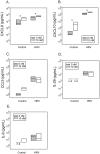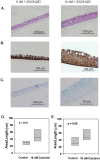Effects of vitamin D on airway epithelial cell morphology and rhinovirus replication
- PMID: 24475177
- PMCID: PMC3901706
- DOI: 10.1371/journal.pone.0086755
Effects of vitamin D on airway epithelial cell morphology and rhinovirus replication
Abstract
Vitamin D has been linked to reduced risk of viral respiratory illness. We hypothesized that vitamin D could directly reduce rhinovirus (RV) replication in airway epithelium. Primary human bronchial epithelial cells (hBEC) were treated with vitamin D, and RV replication and gene expression were evaluated by quantitative PCR. Cytokine/chemokine secretion was measured by ELISA, and transepithelial resistance (TER) was determined using a voltohmmeter. Morphology was examined using immunohistochemistry. Vitamin D supplementation had no significant effects on RV replication, but potentiated secretion of CXCL8 and CXCL10 from infected or uninfected cells. Treatment with vitamin D in the form of 1,25(OH)2D caused significant changes in cell morphology, including thickening of the cell layers (median of 46.5 µm [35.0-69.0] vs. 30 µm [24.5-34.2], p<0.01) and proliferation of cytokeratin-5-expressing cells, as demonstrated by immunohistochemical analysis. Similar effects were seen for 25(OH)D. In addition to altering morphology, higher concentrations of vitamin D significantly upregulated small proline-rich protein (SPRR1β) expression (6.3 fold-induction, p<0.01), suggestive of squamous metaplasia. Vitamin D treatment of hBECs did not alter repair of mechanically induced wounds. Collectively, these findings indicate that vitamin D does not directly affect RV replication in airway epithelial cells, but can influence chemokine synthesis and alters the growth and differentiation of airway epithelial cells.
Conflict of interest statement
Figures





References
-
- Schauber J, Gallo RL (2009) Antimicrobial peptides and the skin immune defense system. J Allergy Clin Immunol 124: R13–R18. - PubMed
-
- Lin R, White JH (2004) The pleiotropic actions of vitamin D. Bioessays. 26: 21–28. - PubMed
-
- Schwalfenberg GK (2011) A review of the critical role of vitamin D in the functioning of the immune system and the clinical implications of vitamin D deficiency. Mol Nutr Food Res 55: 96–108. - PubMed
Publication types
MeSH terms
Substances
Grants and funding
LinkOut - more resources
Full Text Sources
Other Literature Sources
Research Materials

